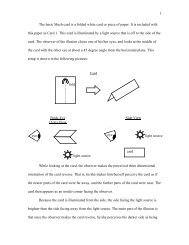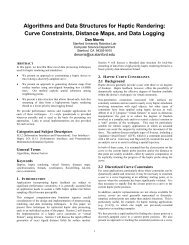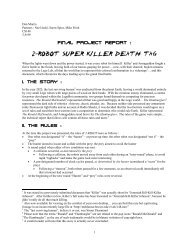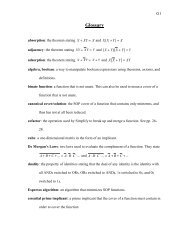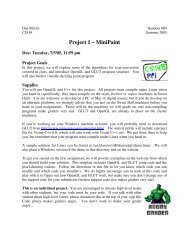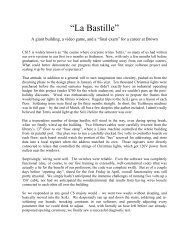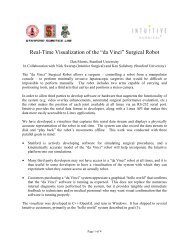What the Hell is the Inertia Tensor?
What the Hell is the Inertia Tensor?
What the Hell is the Inertia Tensor?
Create successful ePaper yourself
Turn your PDF publications into a flip-book with our unique Google optimized e-Paper software.
<strong>What</strong> <strong>the</strong> <strong>Hell</strong> <strong>is</strong> <strong>the</strong> <strong>Inertia</strong> <strong>Tensor</strong>?<br />
An introduction for non-physic<strong>is</strong>ts, by Dan Morr<strong>is</strong><br />
Until recently, <strong>the</strong> depth of my understanding of <strong>the</strong> inertia tensor was that “it tells you how <strong>the</strong><br />
mass of an object <strong>is</strong> d<strong>is</strong>tributed.” I could say that if someone asked me, but I didn’t really know<br />
what it meant. For example, I had no idea what it would mean if you made one element zero, or<br />
increased <strong>the</strong> magnitude of a particular element, etc. I’m writing th<strong>is</strong> tutorial so I don’t forget<br />
what I now understand about <strong>the</strong> inertia tensor… it’s not going to be hugely quantitative, but it<br />
gets some important points across.<br />
First let’s pose a simple physics question: if I have an object with mass m, what force do I need<br />
to apply to get an acceleration a? The answer, of course, comes from Newton’s basic equation<br />
of motion :<br />
F = ma<br />
(1.1)<br />
For a given object with mass m, if I apply a force F, I’ll get an acceleration a. If I apply a force<br />
2*F, I get an acceleration 2*a. If my object gets heavier, I need to apply more force to get <strong>the</strong><br />
same acceleration. Sweet.<br />
Now I want to ask <strong>the</strong> same question for rotation. First let’s assume we have a world with<br />
known axes x, y, and z. And let’s define <strong>the</strong> rotational velocity ω for an object as a three<br />
element-vector (ωx,ωy,ωz) that contains <strong>the</strong> rate at which <strong>the</strong> object <strong>is</strong> spinning around each ax<strong>is</strong>.<br />
If all three are zero, <strong>the</strong> object <strong>is</strong>n’t spinning at all. If ωx <strong>is</strong> <strong>the</strong> only non-zero element, <strong>the</strong> object<br />
<strong>is</strong> spinning nicely around <strong>the</strong> x-ax<strong>is</strong>, etc.<br />
So now I want to know what torque I need to apply to accelerate <strong>the</strong> object’s rotation by some<br />
amount dω. For example, maybe <strong>the</strong> object <strong>is</strong> spinning around <strong>the</strong> x ax<strong>is</strong> with rotational velocity<br />
(ωx,0,0), and I want to stop it in t seconds. So I want to know what torque I need to apply to get<br />
a rotational acceleration of (-ωx / t).<br />
Th<strong>is</strong> <strong>is</strong> where <strong>the</strong> inertia tensor comes in. Just like I have F = ma for linear acceleration and<br />
force, I have <strong>the</strong> following equation for rotation :<br />
τ I * dω<br />
= (1.2)<br />
…where τ <strong>is</strong> torque (a 3-element vector, indicating <strong>the</strong> torque around <strong>the</strong> x, y, and z axes), dω <strong>is</strong><br />
<strong>the</strong> rotational acceleration that we d<strong>is</strong>cussed before (a 3-element vector), and I – of course – <strong>is</strong><br />
<strong>the</strong> magic inertia tensor (a 3-by-3 matrix). Note how it looks just like equation (1.1)!<br />
I’m going to write th<strong>is</strong> equation in matrix form, and we’ll play with it a little bit before we see<br />
where <strong>the</strong> inertia tensor comes from.
In matrix form, <strong>the</strong> above equation looks like :<br />
⎡τx⎤ ⎡Ixx ⎢<br />
τ<br />
⎥ ⎢<br />
= ⎢I Ixy I<br />
I ⎤ xz ⎡dωx⎤ ⎥<br />
I<br />
⎢<br />
dω<br />
⎥<br />
⎥<br />
⎣ ⎦ ⎣ ⎦⎣<br />
⎦<br />
⎢ y⎥ yx yy yz ⎢ y⎥<br />
(1.3)<br />
⎢τ⎥ ⎢<br />
z Izx Izy I ⎥⎢<br />
zz dω⎥<br />
z<br />
Now I’m going to do my best to throw out an intuitive explanation of what some of <strong>the</strong><br />
individual elements of <strong>the</strong> inertia tensor mean in <strong>the</strong> real world. The easy ones are <strong>the</strong> diagonal<br />
elements: Ixx, Iyy, and Izz. In fact, let’s take <strong>the</strong> simple case, where all <strong>the</strong> o<strong>the</strong>r elements in I are<br />
zero. Th<strong>is</strong> happens to be true for any object that’s symmetric around all three axes, like a big<br />
sphere, or a big cube that’s sitting nicely on <strong>the</strong> axes. We’ll deal with <strong>the</strong> o<strong>the</strong>r elements later.<br />
In th<strong>is</strong> case, for example, I can multiply <strong>the</strong> first row of equation (1.3) out, to get :<br />
τ I * dω<br />
x = xx x<br />
(1.4)<br />
Th<strong>is</strong> looks a lot like F = ma. Basically in th<strong>is</strong> case, I can think of Ixx as <strong>the</strong> rotational inertia<br />
around <strong>the</strong> x ax<strong>is</strong>. So for rotation around <strong>the</strong> x ax<strong>is</strong>, Ixx behaves just like <strong>the</strong> m in F=ma. The<br />
bigger my Ixx <strong>is</strong>, <strong>the</strong> more torque I have to apply around <strong>the</strong> x ax<strong>is</strong> to get it to spin. Or,<br />
conversely, for a given torque, a bigger Ixx means I’ll get less rotation around <strong>the</strong> x ax<strong>is</strong>. Just like<br />
m. In case I didn’t mention it, it’s a lot like m.<br />
So for example, what would it mean for Ixx to be zero? It would mean that for a given torque, I<br />
would get an infinite rotational acceleration around <strong>the</strong> x ax<strong>is</strong>. That’s an important lesson. For<br />
real objects, none of <strong>the</strong> diagonal elements in I can be zero, since we know <strong>the</strong>re’s no real object<br />
where a tiny touch will set it spinning at an infinite rate.<br />
Okay, now <strong>the</strong> hard part… what’s <strong>the</strong> deal with <strong>the</strong> off-diagonal elements, for example Ixy. Th<strong>is</strong><br />
question <strong>is</strong> really hard to explain quantitatively without dealing with <strong>the</strong> inverse of <strong>the</strong> inertia<br />
tensor, so I’m going to blow off <strong>the</strong> hard parts and deal with it qualitatively. <strong>What</strong> th<strong>is</strong> element<br />
(Ixy) tells me <strong>is</strong> how much my object will be accelerated around <strong>the</strong> y ax<strong>is</strong> when I apply torque<br />
around <strong>the</strong> x ax<strong>is</strong>.<br />
<strong>What</strong>? How’s that possible? How could spinning an object around one ax<strong>is</strong> make it rotate<br />
around ano<strong>the</strong>r ax<strong>is</strong> too?<br />
For symmetric objects, it can’t. If I take a big uniform cube in space and I torque it around <strong>the</strong> x<br />
ax<strong>is</strong>, intuition (correctly) suggests that it only spins around <strong>the</strong> x ax<strong>is</strong>.<br />
But now let’s say I attach a big-ass weight somewhere on <strong>the</strong> sphere. For example, let’s say I’m<br />
spinning <strong>the</strong> Earth around <strong>the</strong> ax<strong>is</strong> that runs from <strong>the</strong> north pole to <strong>the</strong> south pole (and we’re
pretending of course that <strong>the</strong> Earth <strong>is</strong> a uniform sphere), and I attach a big weight to Canada.<br />
Now suddenly I’ve accelerated that big weight, and it wants to “pull” that part of <strong>the</strong> world along<br />
with it. Th<strong>is</strong> <strong>is</strong> going to make <strong>the</strong> Earth want to “tilt”, so <strong>the</strong> north pole moves along with big<br />
heavy Canada. Th<strong>is</strong> <strong>is</strong> a rotational acceleration along an ax<strong>is</strong> o<strong>the</strong>r than <strong>the</strong> one I torqued!<br />
Okay, so we’re blown away by that, and that’s about as far as I’m going to go with <strong>the</strong> offdiagonal<br />
elements. You can see that <strong>the</strong>y’re always zero for a perfectly symmetric object, so <strong>the</strong><br />
object spins only around <strong>the</strong> axes you torque it around.<br />
Ano<strong>the</strong>r footnote, while we’re on <strong>the</strong> topic… for those of you familiar with rotational bases, it’s<br />
interesting to note that for any object, <strong>the</strong>re’s some bas<strong>is</strong> along which <strong>the</strong> inertia tensor <strong>is</strong><br />
diagonal (all <strong>the</strong> off-diagonal elements are zero). That means that <strong>the</strong>re’s some set of<br />
perpendicular axes (x,y,z) around which I can torque <strong>the</strong> object and get rotational acceleration<br />
only along <strong>the</strong> ax<strong>is</strong> I torqued… ano<strong>the</strong>r way of saying th<strong>is</strong> <strong>is</strong> that <strong>the</strong>re’s some set of “principal<br />
axes” around which an object will “spin stably”, meaning it can spin around those axes without<br />
“wobbling” off-ax<strong>is</strong>. Finding those axes <strong>is</strong> straightforward, but I’m not going to talk about it<br />
here.<br />
The last thing I want to cover <strong>is</strong> how <strong>the</strong> inertia tensor <strong>is</strong> defined… so far we’ve treated it like a<br />
magic quantity that emerges from <strong>the</strong> sky. Let’s look at <strong>the</strong> equations for on of <strong>the</strong> diagonal<br />
elements, which <strong>is</strong> representative of how we’d compute all of <strong>the</strong>m :<br />
2 2<br />
I xx = M ( y + z ) dV<br />
V<br />
∫ (1.5)<br />
Here M represents <strong>the</strong> mass of <strong>the</strong> object, and V <strong>is</strong> <strong>the</strong> volume of <strong>the</strong> object. y and z are <strong>the</strong><br />
positions of a particular point along <strong>the</strong> y and z axes, where zero <strong>is</strong> at <strong>the</strong> center of mass of <strong>the</strong><br />
object (that’s important).<br />
So what does <strong>the</strong> Ixx equation mean? We’re taking an integral over <strong>the</strong> whole volume, and we’re<br />
summing <strong>the</strong> squared d<strong>is</strong>tance of every point from <strong>the</strong> x ax<strong>is</strong> (y 2 +z 2 ). So for a given amount of<br />
mass, I’m going to have a bigger Ixx value if most of my object <strong>is</strong> far away from <strong>the</strong> x ax<strong>is</strong>.<br />
Remember, that means that to get a given acceleration around <strong>the</strong> x ax<strong>is</strong>, I need to apply more<br />
torque around <strong>the</strong> x ax<strong>is</strong>. How can we understand that intuitively?<br />
The classic example for understanding th<strong>is</strong> comes from figure skating… have you ever watched<br />
an ice skater get ready to spin super fast on <strong>the</strong> ice? <strong>What</strong> does he/she do? If he wants to spin<br />
fast, he puts h<strong>is</strong> arms way above h<strong>is</strong> head.<br />
<strong>What</strong> does th<strong>is</strong> have to do with <strong>the</strong> inertia tensor? Imagine <strong>the</strong> ax<strong>is</strong> of <strong>the</strong> skater’s body <strong>is</strong> <strong>the</strong> x<br />
ax<strong>is</strong>. He’s going to spin himself around th<strong>is</strong> ax<strong>is</strong> with some torque (whatever he can generate<br />
with h<strong>is</strong> legs). <strong>What</strong> we’ve learned <strong>is</strong> that <strong>the</strong> lower h<strong>is</strong> Ixx value <strong>is</strong>, <strong>the</strong> more rotational<br />
acceleration he’ll get for that torque. And what we learned just now <strong>is</strong> that he can make h<strong>is</strong> Ixx<br />
value smaller by putting h<strong>is</strong> mass closer to <strong>the</strong> x ax<strong>is</strong>… and he does that by putting h<strong>is</strong> arms –<br />
which carry some of h<strong>is</strong> weight – along <strong>the</strong> ax<strong>is</strong> of h<strong>is</strong> body. Amazing.
Ano<strong>the</strong>r way to think of th<strong>is</strong>… if <strong>the</strong> ice skater holds h<strong>is</strong> hands way out (which makes Ixx<br />
bigger), and he wants to rotate h<strong>is</strong> whole body at a certain rate, h<strong>is</strong> hands are going to have to<br />
move much faster than h<strong>is</strong> feet (because <strong>the</strong>y cover more ground each time he spins around, just<br />
like <strong>the</strong> horses at <strong>the</strong> outside of a merry-go-round have to move faster than <strong>the</strong> inner ones). So if<br />
he sticks h<strong>is</strong> hands out, and he has to move some of h<strong>is</strong> mass hella fast, it’s intuitive that he<br />
should have to apply more torque to get <strong>the</strong> same rotational velocity. Voila, we have Ixx.<br />
And now, of course, we hit <strong>the</strong> off-diagonal elements. The equation for Ixy looks like th<strong>is</strong> :<br />
I M xydV<br />
xy<br />
=− ∫ V<br />
(1.6)<br />
Unfortunately, we’re again stuck with <strong>the</strong> fact that th<strong>is</strong> <strong>is</strong> really hard to explain, since (a) I don’t<br />
understand it that well and (b) it’s hard to reason about <strong>the</strong> counter-intuitive effect that applying<br />
torque along one ax<strong>is</strong> can induce rotation around ano<strong>the</strong>r ax<strong>is</strong>. But we can see how we compute<br />
th<strong>is</strong> component, and we can get a couple interesting points out of it.<br />
Possibly <strong>the</strong> most important <strong>is</strong> that if <strong>the</strong> object <strong>is</strong> symmetric, every point on one side of each<br />
ax<strong>is</strong> <strong>is</strong> going to “cancel out” <strong>the</strong> corresponding point on <strong>the</strong> o<strong>the</strong>r side of <strong>the</strong> ax<strong>is</strong>. Hence we get<br />
off-diagonal elements that are zero, just like we d<strong>is</strong>cussed above.<br />
Ano<strong>the</strong>r thing we notice <strong>is</strong> that Ixy will be exactly <strong>the</strong> same as Iyx, since <strong>the</strong> inside of <strong>the</strong> above<br />
integral <strong>is</strong> just xy, which <strong>is</strong> <strong>the</strong> same as yx. Th<strong>is</strong> tells us that all inertia tensors are symmetric,<br />
which makes <strong>the</strong>m numerically friendly for many applications.<br />
Okay, I’m going to stop <strong>the</strong>re… th<strong>is</strong> was just my way of re-iterating my basic intuition for <strong>the</strong><br />
inertia tensor. I’m not about to solve hard problems in mechanics, but th<strong>is</strong> intuition <strong>is</strong> typically<br />
more than enough to implement and reason about algorithms in physical simulation. Ano<strong>the</strong>r<br />
good resource <strong>is</strong> <strong>the</strong> popular SIGGRAPH mini-course on physical simulation :<br />
http://www-2.cs.cmu.edu/~baraff/sigcourse/<br />
Good luck, and happy tensor-ing.<br />
-Dan



